There's something magical about pulling a tray of golden, caramelized vegetables from the oven and building them into a nourishing bowl. Roasted veggie bowls have become my go-to meal when I want something healthy, satisfying, and ridiculously easy to throw together. Whether you're meal prepping for the week or need a quick weeknight dinner, these roasted veggie bowls deliver big flavor with minimal effort.
The best part? You can customize your roasted veggie bowls with whatever vegetables are in season or hiding in your fridge. From sweet potatoes and chickpeas to Brussels sprouts and bell peppers, everything gets better with a little olive oil and high heat. Let's dive into creating the ultimate roasted veggie bowls that'll have you looking forward to healthy eating.
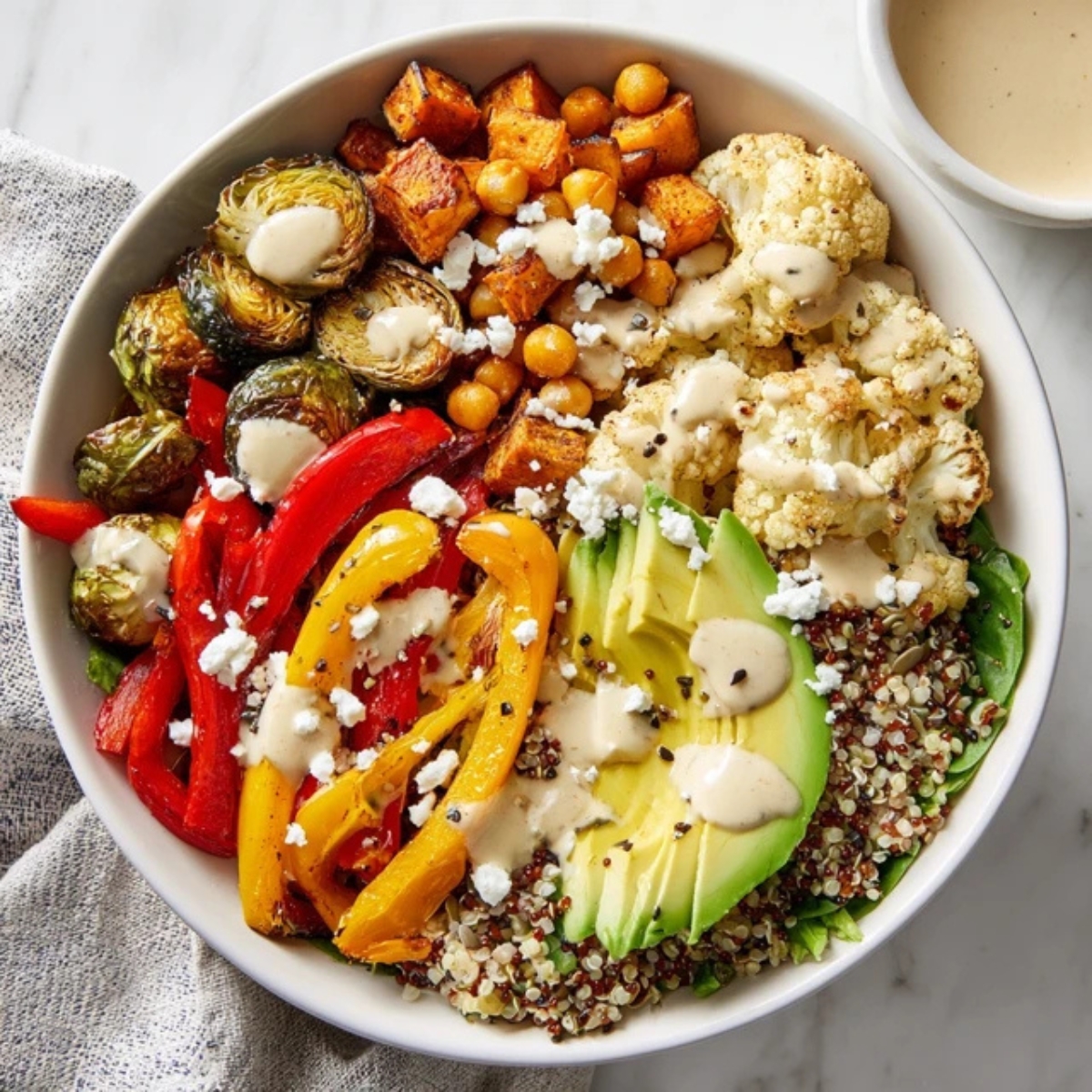
Background & Why This Recipe Stands Out
Roasted veggie bowls have taken over the health food scene for good reason. They combine the comfort of warm, roasted vegetables with the freshness of grain bowls and the satisfaction of a complete meal. Unlike steamed or raw veggie bowls, roasting brings out natural sweetness and creates those crispy, caramelized edges that make vegetables irresistible. These roasted veggie bowls work perfectly whether you're following a plant-based diet, trying to eat more whole foods, or simply looking for a delicious way to get your daily vegetables.
What sets this recipe apart is its flexibility and simplicity. You don't need fancy ingredients or complicated techniques to create restaurant-quality roasted veggie bowls at home. The secret is in the roasting method and the flavorful tahini dressing that ties everything together. These bowls are naturally vegan, gluten-free (when made with quinoa or rice), and packed with fiber, vitamins, and plant-based protein. They're proof that healthy eating doesn't have to be boring or time-consuming.
Jump to:
Ingredients
For the Roasted Vegetables:
- Sweet potato, cubed (1-inch pieces)
- Brussels sprouts, halved
- Red bell pepper, chopped
- Cauliflower florets
- Chickpeas, drained and patted dry
- Olive oil
- Smoked paprika
- Garlic powder
- Cumin
- Salt and black pepper to taste
For the Base:
- Coked quinoa (or brown rice, farro, or your favorite grain)
- Mixed greens or baby spinach
For the Maple Dijon Tahini Dressing:
- Tahini
- Maple syrup
- Dijon mustard
- Lemon juice
- Water (to thin)
- Salt
Optional Toppings:
- Fresh avocado slices
- Crumbled feta cheese
- Pumpkin seeds or sunflower seeds
- Fresh herbs (parsley or cilantro)
- Hemp hearts
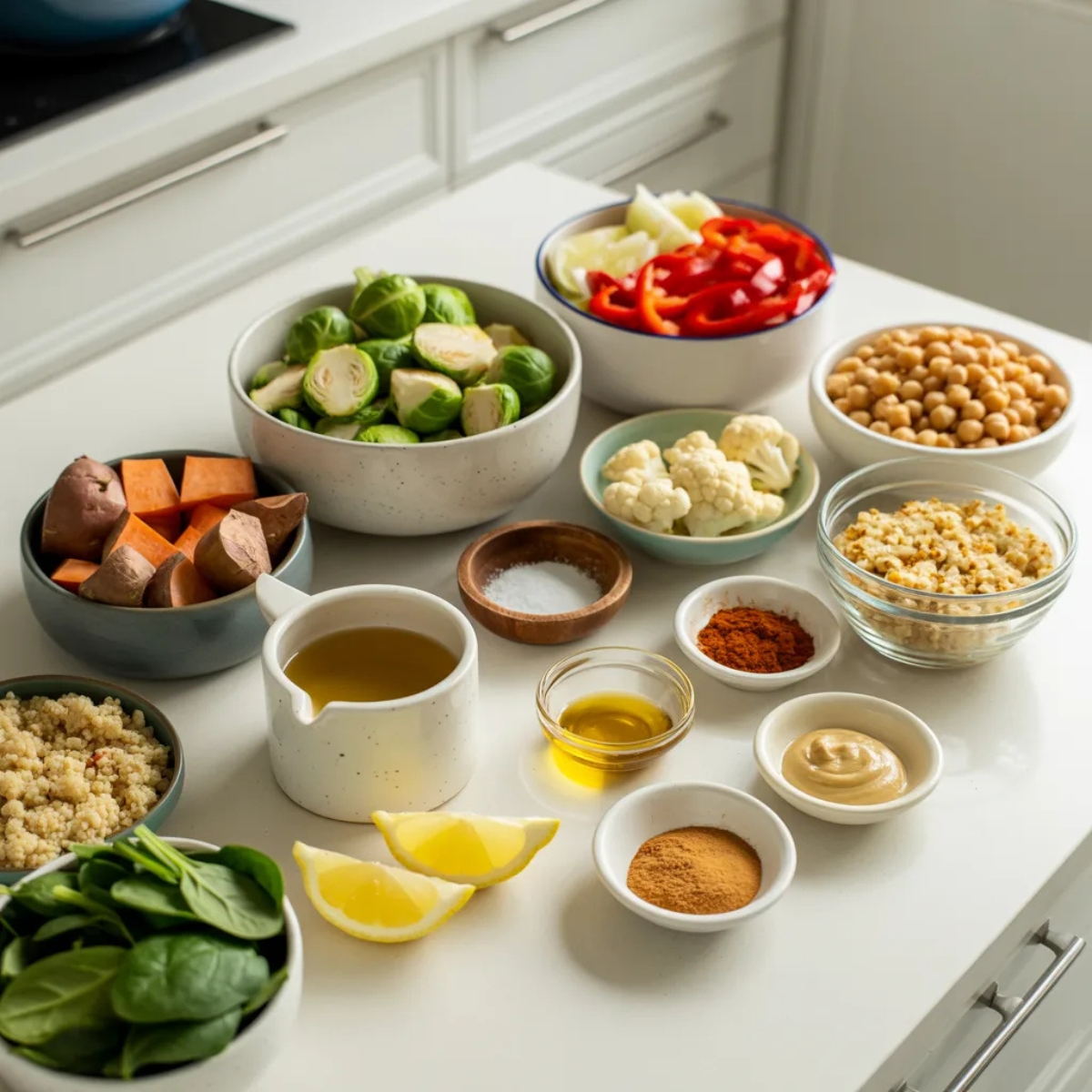
See recipe card for quantities.
Instructions
Step 1: Prep Your Vegetables
- Preheat your oven to 425°F (220°C) and line two large baking sheets with parchment paper.
- Wash and chop all vegetables into similar-sized pieces for even roasting.
- Pat the chickpeas completely dry with paper towels; this is crucial for crispiness.
- Separate vegetables by roasting time; hard vegetables like sweet potatoes go on one sheet, softer ones like bell peppers on another.
Step 2: Season and Roast
- Divide vegetables and chickpeas between the two prepared baking sheets.
- Drizzle with olive oil and sprinkle with smoked paprika, garlic powder, cumin, salt, and pepper.
- Toss everything well, making sure each piece is coated with oil and spices.
- Spread vegetables in a single layer without overcrowding; this prevents steaming and promotes caramelization.
- Roast for 25-30 minutes, flipping halfway through, until vegetables are tender and golden with crispy edges.
Step 3: Make the Tahini Dressing
- While vegetables roast, combine tahini, maple syrup, Dijon mustard, and lemon juice in a small bowl.
- Whisk together until smooth; the mixture will thicken at first.
- Add water one tablespoon at a time, whisking until you reach a drizzle-able consistency.
- Taste and adjust seasoning with salt or more lemon juice if needed.
Step 4: Assemble Your Roasted Veggie Bowls
- Start with a base of cooked quinoa or your chosen grain in each bowl.
- Add a handful of fresh mixed greens on one side.
- Arrange the warm roasted vegetables and chickpeas on top.
- Drizzle generously with the maple Dijon tahini dressing.
- Add your favorite toppings like avocado, feta, or seeds for extra flavor and texture.
Expert Cooking Tips
Getting perfect roasted veggie bowls every time comes down to a few key techniques:
- Temperature Matters Always roast at 425°F or higher. High heat is what creates those caramelized, crispy edges that make roasted vegetables so addictive. Lower temperatures will steam rather than roast your vegetables.
- Don't Crowd the Pan This is the biggest mistake people make. Overcrowded vegetables release moisture and steam instead of roasting. Use two baking sheets if needed, and make sure there's space between each piece.
- Cut Consistently Chop vegetables into similar-sized pieces so they cook evenly. Smaller pieces will burn while larger ones stay raw if sizes vary too much.
- Dry Your Chickpeas For crispy chickpeas, pat them completely dry with paper towels before tossing with oil. Any moisture will prevent them from getting that crunchy texture.
- Flip Halfway Turn vegetables once during roasting to get caramelization on multiple sides. This also prevents burning on the bottom.
- Season Generously Vegetables can handle more seasoning than you think. Don't be shy with the spices, salt, and pepper; roasting mellows their flavors.
Recipe Variations & Substitutions
One of the best things about roasted veggie bowls is how easily you can customize them to your preferences and what you have on hand.
Vegetable Swaps Try butternut squash instead of sweet potato, or use broccoli, zucchini, mushrooms, cherry tomatoes, or carrots. Seasonal vegetables work beautifully; in fall, add cubed squash and red onions; in summer, use zucchini and eggplant. Root vegetables like parsnips and beets also roast wonderfully.
Protein Options
- Add grilled chicken for a spicy roasted veggie and chicken buddha bowl
- Keep it vegan with the chickpeas or add baked tofu
- Top with a fried or soft-boiled egg
- Sprinkle with nuts or seeds for plant-based protein
- Add white beans or black beans instead of chickpeas
Grain Alternatives
- Brown rice for a heartier, nuttier base
- Farro or wheat berries for a chewy texture
- Cauliflower rice for a low-carb option
- Wild rice blend for more interesting texture
- Couscous or bulgur for quick preparation
Dressing Variations
- Make it creamy with hummus thinned with lemon juice
- Try a lemon herb vinaigrette for a lighter option
- Use a golden turmeric tahini sauce for anti-inflammatory benefits
- Drizzle with balsamic glaze for sweetness
- Make it spicy with sriracha mixed into your tahini dressing
Equipment Recommendations
Having the right tools makes preparing roasted veggie bowls even easier:
- Large Rimmed Baking Sheets: Two 18x13-inch half-sheet pans are perfect for roasting without overcrowding
- Parchment Paper or Silicone Mats: Prevents sticking and makes cleanup a breeze
- Sharp Chef's Knife: For quick, even vegetable prep
- Large Mixing Bowl: To toss vegetables with oil and seasonings
- Wire Cooling Rack: Place under baking sheets for even heat circulation
- Meal Prep Containers: Glass containers with dividers keep components fresh and separate
Storage & Meal Prep Tips
Roasted veggie bowls are meal prep champions. Here's how to keep them fresh and delicious:
- Refrigerator Storage Store each component separately in airtight containers. Roasted vegetables keep for 4-5 days, cooked quinoa lasts up to 5 days, and the tahini dressing stays fresh for a week. Keep mixed greens separate and unwashed until you're ready to eat. Store the dressing in a small jar or squeeze bottle for easy drizzling.
- Freezer Storage Roasted vegetables freeze surprisingly well for up to 3 months. Let them cool completely before transferring to freezer bags, removing as much air as possible. Cooked quinoa also freezes beautifully. Don't freeze the fresh greens or dressing; make these fresh when you're ready to eat.
- Reheating Tips Reheat roasted vegetables in a 350°F oven for 10 minutes to restore their texture, or microwave for 1-2 minutes. You can eat the roasted veggie bowls cold as a grain salad or warm for a cozy meal. Add the dressing and fresh components right before serving for the best texture.
- Meal Prep Strategy On Sunday, roast a big batch of vegetables and cook your grains. Portion everything into containers, but keep dressing separate. Each morning, grab a container and add fresh greens and dressing. You'll have healthy roasted veggie bowls ready in minutes all week long.
Grandma's Secret That Changed Everything
Here's something most recipes won't tell you about making the most incredible roasted veggie bowls: the secret is in the pan temperature before the vegetables hit it. Preheat your baking sheets in the hot oven for 5 minutes before adding your vegetables. When the vegetables hit that hot surface, they immediately start caramelizing instead of releasing moisture. This single trick transforms ordinary roasted vegetables into restaurant-quality perfection.
The second secret is in the seasoning timing. Instead of mixing everything together at once, toss your vegetables with oil first, then add the spices. The oil helps the seasonings stick evenly to every surface. For your roasted veggie bowls to have maximum flavor, season again lightly with flaky sea salt right when they come out of the oven while they're still hot. That final touch of salt brings all the flavors to life.
FAQ
What is the secret to extra crispy roasted vegetables?
The secret to crispy roasted vegetables in your roasted veggie bowls is threefold: high heat (425°F or higher), dry vegetables, and space on the pan. Pat vegetables completely dry before tossing with oil, spread them in a single layer with space between pieces, and resist the urge to stir too often. Moisture is the enemy of crispiness.
What veggies are good roasted together?
The best vegetables for roasted veggie bowls are those with similar cooking times. Pair hard vegetables like sweet potatoes, carrots, and Brussels sprouts together, and softer vegetables like bell peppers, zucchini, and mushrooms on a separate pan. You can also add vegetables at different times; start with harder vegetables and add softer ones halfway through.
Are veggies still healthy when roasted?
Absolutely! Roasted vegetables in your roasted veggie bowls retain most of their nutrients and some, like lycopene in tomatoes and beta-carotene in carrots, become more available to your body when cooked. Roasting with a moderate amount of healthy oil like olive oil actually helps your body absorb fat-soluble vitamins. Just avoid burning them, which can reduce nutrient content.
What are the tastiest vegetables to roast?
For amazing roasted veggie bowls, the tastiest vegetables include sweet potatoes, Brussels sprouts, cauliflower, broccoli, bell peppers, carrots, and butternut squash. These vegetables develop natural sweetness and crispy, caramelized edges when roasted. Chickpeas also roast beautifully and add protein and crunch. Choose vegetables with lower water content for the best texture and flavor.
Your New Go-To Healthy Meal
Roasted veggie bowls have earned their place as a modern kitchen staple, and for good reason. They're endlessly adaptable, genuinely delicious, and make healthy eating feel like a treat rather than a chore. Whether you're meal prepping for busy weekdays or throwing together a quick dinner, these colorful roasted veggie bowls deliver nutrition and satisfaction in every bite. The combination of caramelized vegetables, wholesome grains, and that creamy tahini dressing creates a meal that's far more than the sum of its parts.
Now that you know all the tricks for perfect roasted veggie bowls, it's time to get creative in your kitchen. Try different vegetable combinations, experiment with various dressings, and make these bowls your own. For more nourishing bowl inspiration, check out our Winter Harvest Dinner Bowl Recipe for a cozy seasonal twist, or spice things up with our Hot Honey Chicken Bowl Recipe. Both recipes follow the same simple bowl-building principles that make roasted veggie bowls so satisfying. Happy roasting!
With love from my kitchen to yours,
Aubrey James
Related
Looking for other recipes like this? Try these:
Pairing
These are my favorite dishes to serve with this Roasted veggie bowls recipe:

Roasted Veggie Bowls Recipe
Equipment
- 2 Large rimmed baking sheets For roasting vegetables evenly
- 1 Parchment paper or silicone baking mats Prevents sticking and makes cleanup easy
- 1 Sharp Chef’s Knife For even chopping
- 1 Large mixing bowl To toss veggies with oil and spices
- 1 Wire cooling rack (optional) For better air circulation under pans
- 4 Meal prep containers Keeps components fresh for storage
Ingredients
Roasted Vegetables
- 2 cups Sweet potato Cubed into 1-inch pieces
- 2 cups Brussels sprouts Halved
- 1 cup Red bell pepper Chopped
- 1 cup Cauliflower florets
- 1 can (15 oz) Chickpeas Drained and patted dry
- 3 tablespoon Olive oil
- 1 teaspoon Smoked paprika
- 1 teaspoon Garlic powder
- 0.5 teaspoon Ground cumin
- 0.5 teaspoon Salt Or to taste
- 0.25 teaspoon Black pepper To taste
Base
- 2 cups Cooked quinoa Or brown rice, farro, or your favorite grain
- 2 cups Mixed greens or baby spinach
Maple Dijon Tahini Dressing
- 0.25 cup Tahini
- 2 tablespoon Maple syrup
- 1 tablespoon Dijon mustard
- 2 tablespoon Lemon juice Freshly squeezed
- 2-3 tablespoon Water To thin as needed
- 0.25 teaspoon Salt
Optional Toppings
- Fresh avocado slices
- Crumbled feta cheese
- Pumpkin or sunflower seeds
- Fresh herbs Parsley or cilantro
- Hemp hearts
Instructions
- Preheat oven to 425°F (220°C) and line baking sheets with parchment paper. Chop vegetables evenly and pat chickpeas dry.
- Toss veggies and chickpeas with olive oil, spices, salt, and pepper until coated.
- Spread in a single layer and roast for 25–30 minutes, flipping halfway, until golden and crispy.
- Whisk together tahini, maple syrup, Dijon, lemon juice, and water until smooth and drizzle-able.
- Layer grains, greens, and roasted veggies in bowls. Drizzle with dressing and add toppings.
- Enjoy warm or refrigerate for meal prep throughout the week.

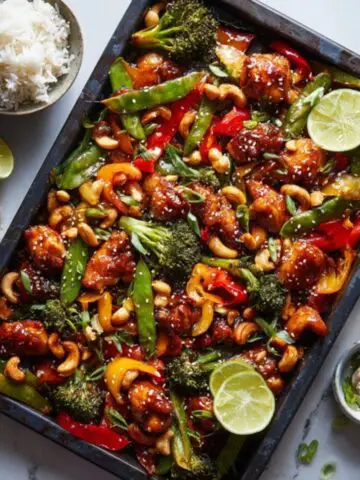
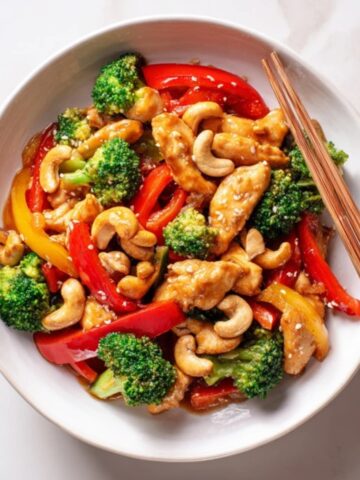
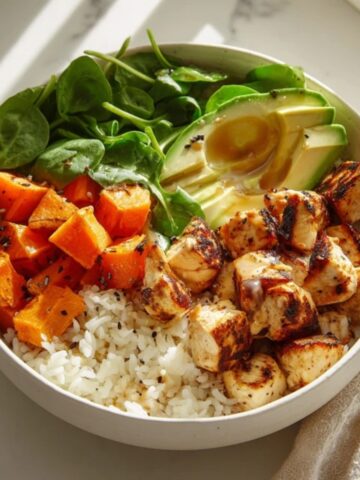
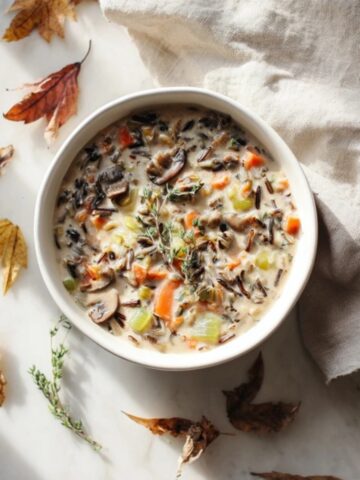



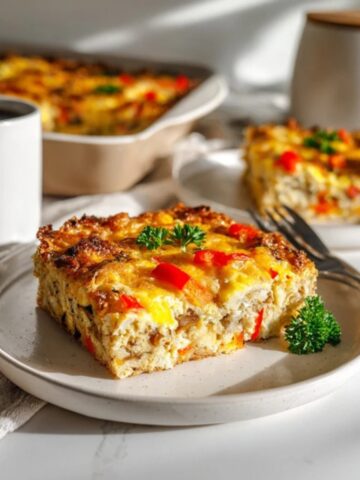
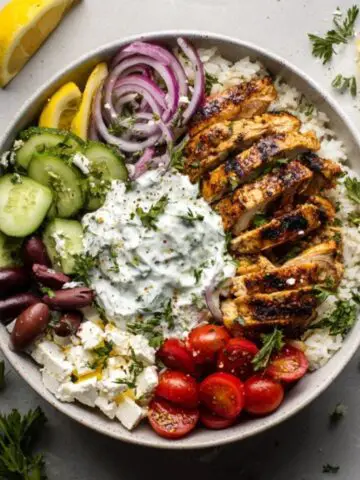
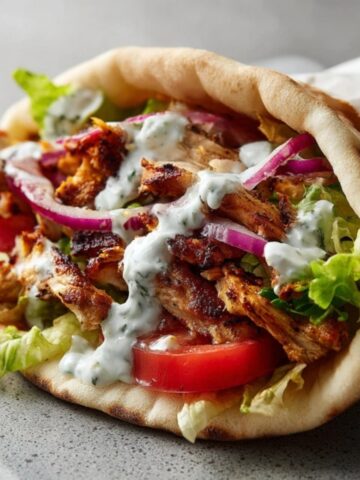
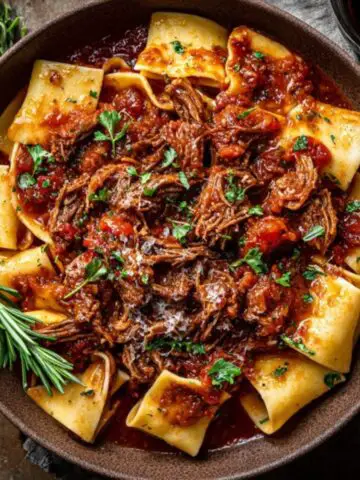
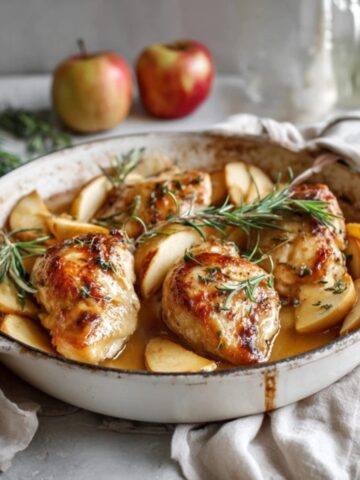
Leave a Reply